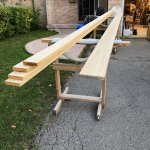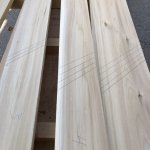This will be a somewhat ambitious build ( at least for me), the design will be a 15' solo cedar strip with a max weight of 30 pounds and still be tripping tough. I also want to take a hand in the design portion and I don't intend to resort to one of the standard CAD programs as they are just a tad confusing and seem to suck the joy out of the design process (again, for me).
I thought it may also be useful to include some of the thought behind the decisions, the time it took to do some of the operations and the cost of various materials/decisions.
My last solo weighed 39 pounds and was a 16' modified Freedom Solo .... so before I do anything, I need to figure out a way to achieve a 9 pound weight reduction on paper to make sure the build is even doable.
My last WRC hull weighed in at ~19 pounds using 1/4" strips ..... so I changed materials to Northern White Cedar to get a 10% density advantage and save 1.8 pounds off the top.
Next do I really need 16', the answer is that a 15' should do fine, that will save another 1.5 - 2 pounds.
Now the hull composite, can I change that up to save some weight?
First thoughts are moving to 4 oz fiberglass and maybe reducing the strip thickness, but this all could be a slippery slope as far as strength and integrity for the planned usage.
During my research, I found this nice little table on the epoxy works site ( https://www.epoxyworks.com/index.php/how-tough-are-they/ ) and it provided the information I needed, going from 6 oz to 4 oz cloth will give a nice weight reduction at the cost of significantly reduced hull strength. Surprisingly, with 6 oz cloth, reducing the strip thickness from 1/4" to 3/16" gives the best weight reduction with virtually no loss in hull strength.
So moving from 1/4" to 3/16" strips should provide a further 4.75 pound reduction (at least).
That brings the potential weight savings to 8.5 pounds, almost there (on paper at least) and eliminating decks will put the reduction about where it needs to be (fingers crossed).
Since I want to have some hand in the design, most of the software programs suggest starting with a known design and modify from there. On paper, I will start with the basic shape of a friends 14' solo I like and modify the bow and stern sections to incorporate a re curve, stretch the length to ~15' and modify the width to be slightly less than my Freedom Solo.
Next post I will actually start on the build process.
Brian
I thought it may also be useful to include some of the thought behind the decisions, the time it took to do some of the operations and the cost of various materials/decisions.
My last solo weighed 39 pounds and was a 16' modified Freedom Solo .... so before I do anything, I need to figure out a way to achieve a 9 pound weight reduction on paper to make sure the build is even doable.
My last WRC hull weighed in at ~19 pounds using 1/4" strips ..... so I changed materials to Northern White Cedar to get a 10% density advantage and save 1.8 pounds off the top.
Next do I really need 16', the answer is that a 15' should do fine, that will save another 1.5 - 2 pounds.
Now the hull composite, can I change that up to save some weight?
First thoughts are moving to 4 oz fiberglass and maybe reducing the strip thickness, but this all could be a slippery slope as far as strength and integrity for the planned usage.
During my research, I found this nice little table on the epoxy works site ( https://www.epoxyworks.com/index.php/how-tough-are-they/ ) and it provided the information I needed, going from 6 oz to 4 oz cloth will give a nice weight reduction at the cost of significantly reduced hull strength. Surprisingly, with 6 oz cloth, reducing the strip thickness from 1/4" to 3/16" gives the best weight reduction with virtually no loss in hull strength.
So moving from 1/4" to 3/16" strips should provide a further 4.75 pound reduction (at least).
That brings the potential weight savings to 8.5 pounds, almost there (on paper at least) and eliminating decks will put the reduction about where it needs to be (fingers crossed).
Since I want to have some hand in the design, most of the software programs suggest starting with a known design and modify from there. On paper, I will start with the basic shape of a friends 14' solo I like and modify the bow and stern sections to incorporate a re curve, stretch the length to ~15' and modify the width to be slightly less than my Freedom Solo.
Next post I will actually start on the build process.
Brian











